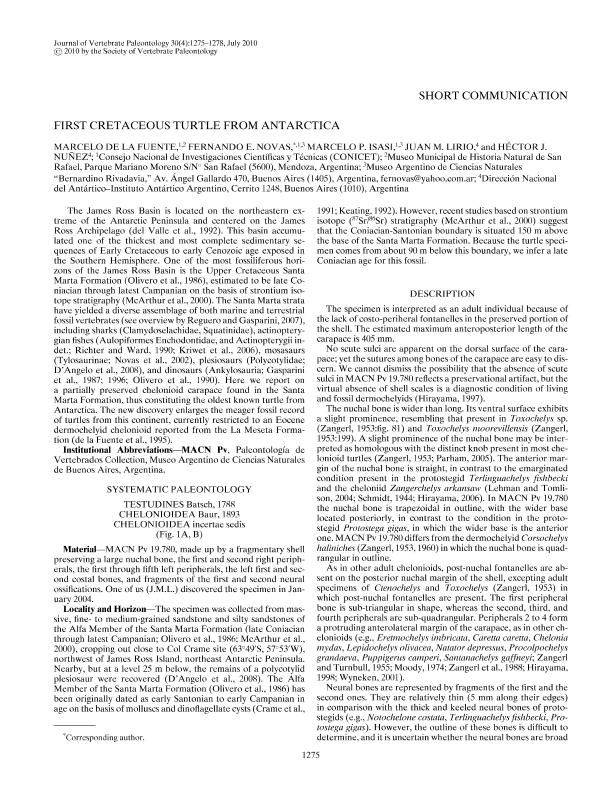Artículo
First Cretaceous turtle from Antarctica
de la Fuente, Marcelo Saul ; Novas, Fernando Emilio
; Novas, Fernando Emilio ; Isasi, Marcelo Pablo
; Isasi, Marcelo Pablo ; Lirio, Juan Manuel; Nuñez, Héctor J.
; Lirio, Juan Manuel; Nuñez, Héctor J.
 ; Novas, Fernando Emilio
; Novas, Fernando Emilio ; Isasi, Marcelo Pablo
; Isasi, Marcelo Pablo ; Lirio, Juan Manuel; Nuñez, Héctor J.
; Lirio, Juan Manuel; Nuñez, Héctor J.
Fecha de publicación:
07/2010
Editorial:
Society of Vertebrate Paleontology
Revista:
Journal of Vertebrate Paleontology
ISSN:
0272-4634
Idioma:
Inglés
Tipo de recurso:
Artículo publicado
Clasificación temática:
Resumen
The James Ross Basin is located on the NE extreme of the Antarctic Peninsula and centered on the James Ross Archipelago (del Valle et al., 1992). This basin accumulated one of the thickest and most complete sedimentary sequences of Lower Cretaceous through Lower Cenozoic ages exposed on the southern hemisphere. One of the paleontologically most productive horizons of the James Ross Basin is the Upper Cretaceous Santa Marta Formation (Olivero et al., 1986), estimated to be Late Coniacian through Latest Campanian on the basis of strontium isotope stratigraphy (McArthur et al., 2000). The Santa Marta beds yielded a diverse assemblage of both marine and terrestrial fossil vertebrates (see overview by Reguero and Gasparini, 2007), including sharks (Clamydoselachidae, Squatinidae), actinopterygian fishes (Aulopiformes Enchodontidae, and Actinopterygii indet.; Richter and Ward, 1990; Kriwet et al., 2006), mosasaurs (Tylosaurinae; Novas et al., 2002), plesiosaurs (Polycotylidae; D´Angelo et al., 2008), and dinosaurs (Ankylosauria; Gasparini et al., 1987; 1996; Olivero et al., 1990). Here we report on a partially preserved chelonioid carapace found in levels of the Santa Marta Formation, thus constituting the oldest-known turtle from Antarctica. The new discovery enlarges the meager fossil record of turtles from this continent, currently restricted to an Eocene demochelyid chelonioid reported from the La Meseta Formation (de la Fuente et al., 1995).
Palabras clave:
Turtle
,
Cretaceous
,
Antarctica
,
Paleobiogeography
Archivos asociados
Licencia
Identificadores
Colecciones
Articulos(IANIGLA)
Articulos de INST. ARG. DE NIVOLOGIA, GLACIOLOGIA Y CS. AMBIENT
Articulos de INST. ARG. DE NIVOLOGIA, GLACIOLOGIA Y CS. AMBIENT
Articulos(MACNBR)
Articulos de MUSEO ARG.DE CS.NAT "BERNARDINO RIVADAVIA"
Articulos de MUSEO ARG.DE CS.NAT "BERNARDINO RIVADAVIA"
Citación
de la Fuente, Marcelo Saul; Novas, Fernando Emilio; Isasi, Marcelo Pablo; Lirio, Juan Manuel; Nuñez, Héctor J.; First Cretaceous turtle from Antarctica; Society of Vertebrate Paleontology; Journal of Vertebrate Paleontology; 30; 4; 7-2010; 1275-1278
Compartir
Altmétricas



